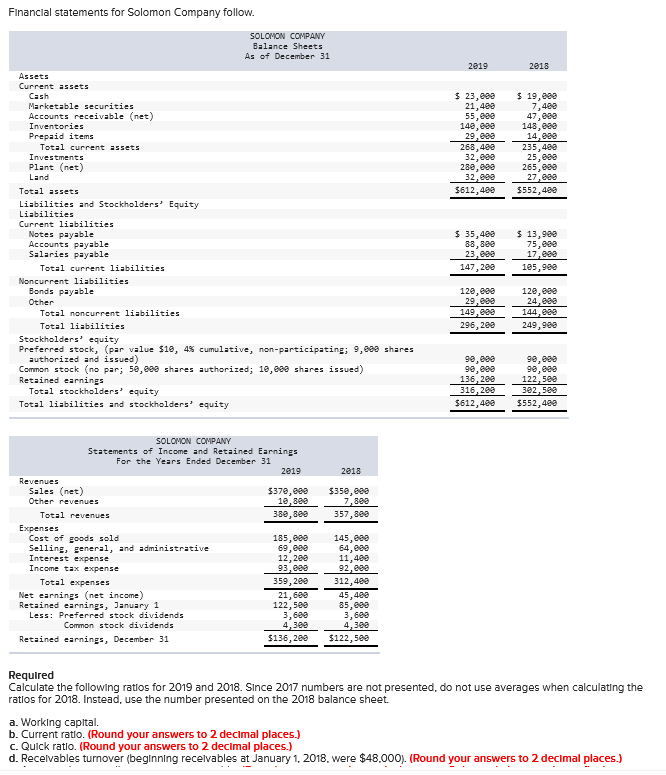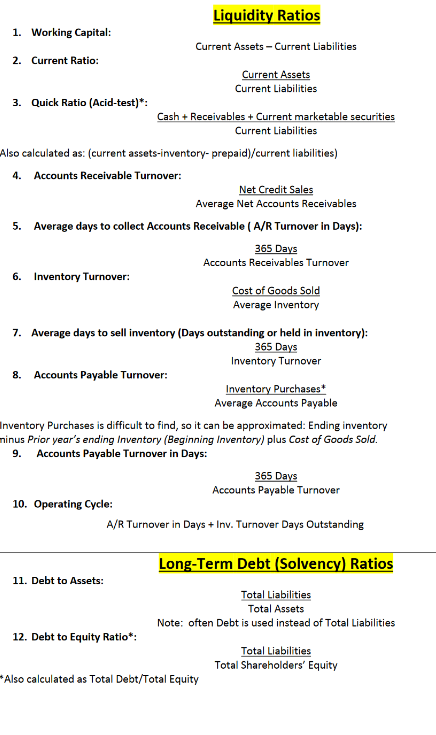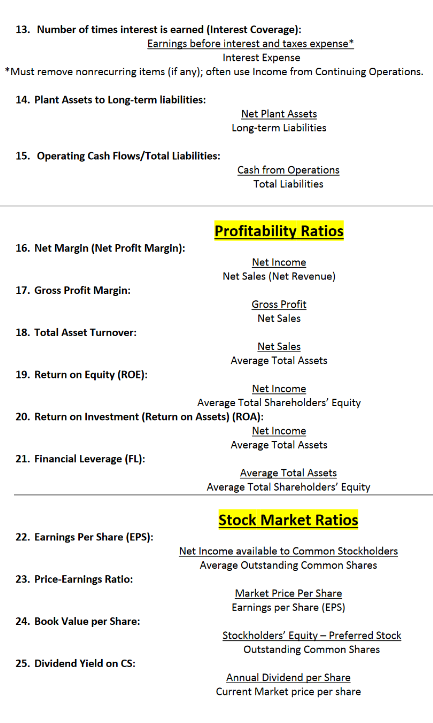Find correct answers and replace the incorrect answers, ratios formulas also provided. Answer must be correct.



Financial statements for Solomon Company follow. 2019 2018 Assets Current assets Cash $ 23,000 $ 19,000 Marketable securities 7,400 Accounts receivable (net) 21,400 55,000 140,000 47,800 Inventories 148,000 Prepaid items 29,000 14,000 Total current assets 268,400 235,400 Investments 32,000 25,000 280,000 265,000 Plant (net) Land 32,000 27,000 Total assets $612,400 $552,400 Liabilities and Stockholders' Equity Liabilities Current liabilities Notes payable $ 35,400 $ 13,900 Accounts payable 88,800 75,000 Salaries payable 23,000 17,000 Total current liabilities 147,200 105,900 Noncurrent liabilities Bonds payable 120,000 120,000 Other 29,000 24,000 Total noncurrent liabilities 149,000 144,000 Total liabilities 296, 200 249,900 Stockholders' equity Preferred stock, (par value $10, 4% cumulative, non-participating; 9,000 shares authorized and issued) 90,000 90,000 90,000 90,000 Common stock (no par; 50,000 shares authorized; 10,000 shares issued) Retained earnings 136,200 122,500 Total stockholders' equity 316,200 302,500 Total liabilities and stockholders' equity $612,400 $552,400 SOLOMON COMPANY Statements of Income and Retained Earnings For the Years Ended December 31 2019 2018 Revenues $370,000 $350,000 10,800 7,800 Total revenues 380,800 357,800 Cost of goods sold 185,000 145,000 Selling, general, and administrative 69,000 64,000 Interest expense 12,200 11,400 Income tax expense 93,000 92,000 Total expenses 359, 200 312,400 Net earnings (net income) 21,600 45,400 Retained earnings, January 1 122,500 85,000 3,600 Less: Preferred stock dividends Common stock dividends 3,600 4,300 4,300 Retained earnings, December 31 $136,200 $122,500 Required Calculate the following ratios for 2019 and 2018. Since 2017 numbers are not presented, do not use averages when calculating the ratios for 2018. Instead, use the number presented on the 2018 balance sheet. a. Working capital. b. Current ratio. (Round your answers to 2 decimal places.) c. Quick ratio. (Round your answers to 2 decimal places.) d. Receivables turnover (beginning receivables at January 1, 2018, were $48,000). (Round your answers to 2 decimal places.) Sales (net) Other revenues Expenses SOLOMON COMPANY Balance Sheets As of December 31 Required Calculate the following ratios for 2019 and 2018. Since 2017 numbers are not presented, do not use averages when calculating the ratios for 2018. Instead, use the number presented on the 2018 balance sheet. a. Working capital. b. Current ratio. (Round your answers to 2 decimal places.) c. Quick ratio. (Round your answers to 2 decimal places.) d. Receivables turnover (beginning receivables at January 1, 2018, were $48,000). (Round your answers to 2 decimal places.) e. Average days to collect accounts receivable. (Round your intermediate calculations to 2 decimal places and your final answers to the nearest whole number.) f. Inventory turnover (beginning Inventory at January 1, 2018, was $154,000). (Round your answers to 2 decimal places.) g. Number of days to sell Inventory. (Round your intermediate calculations to 2 decimal places and your final answers to the nearest whole number.) h. Debt to assets ratio. (Round your answers to the nearest whole percent.) 1. Debt to equity ratio. (Round your answers to 2 decimal places.) J. Number of times Interest was earned. (Round your answers to 2 decimal places.) k. Plant assets to long-term debt. (Round your answers to 2 decimal places.) I. Net margin. (Round your answers to 2 decimal places.) m. Turnover of assets. (Round your answers to 2 decimal places.) n. Return on Investment. (Round your answers to 2 decimal places.) o. Return on equity. (Round your answers to 2 decimal places.) p. Earnings per share. (Round your answers to 2 decimal places.) q. Book value per share of common stock. (Round your answers to 2 decimal places.) r. Price-earnings ratio (market price per share: 2018, $12.45; 2019, $13.90). (Round your intermediate calculations and final answer to 2 decimal places.) s. Dividend yield on common stock. (Round your answers to 2 decimal places.) Answer is complete but not entirely correct. 2019 2018 a. Working capital $ 121,200 $ 129,500 b. Current ratio 1.82 C. Quick ratio 0.68 d. Receivables turnover 7.25 times Average days to collect accounts receivable e. 50 days f. Inventory turnover 1.32 x times 277 x days 9. Average days to sell inventory h. Debt to assets ratio 48 % i. Debt to equity ratio 0.94 lj. Number of times interest earned 10.39 times 1.88 Plant assets to long-term debt Net margin 5.84 % Asset turnover 0.60 x Return on investment 3.53 % Return on equity 6.83 x % Earnings per share 2.16 x per share Book value per share 22.62 per share Price-earnings ratio 6.44 x Dividend yield 3.09 % k. I. m. n. P. 9. r. S. 2.22 0.69 7.37 times days 50 0.98 x times 372 x days 45 % 0.83 13.05 times 1.84 12.97 % 0.63 8.22 % 15.00 % 4.54 x per share 21.25 per share 2.74x 3.45% Liquidity Ratios Current Assets - Current Liabilities Current Assets Current Liabilities Cash + Receivables + Current marketable securities Current Liabilities 1. Working Capital: 2. Current Ratio: 3. Quick Ratio (Acid-test)*: Also calculated as: (current assets-inventory- prepaid)/current liabilities) 4. Accounts Receivable Turnover: Net Credit Sales Average Net Accounts Receivables 5. Average days to collect Accounts Receivable (A/R Turnover in Days): 365 Days Accounts Receivables Turnover 6. Inventory Turnover: Cost of Goods Sold Average Inventory 7. Average days to sell inventory (Days outstanding or held in inventory): 365 Days Inventory Turnover 8. Accounts Payable Turnover: Inventory Purchases* Average Accounts Payable Inventory Purchases is difficult to find, so it can be approximated: Ending inventory ninus Prior year's ending Inventory (Beginning Inventory) plus Cost of Goods Sold. 9. Accounts Payable Turnover in Days: 365 Days Accounts Payable Turnover 10. Operating Cycle: A/R Turnover in Days + Inv. Turnover Days Outstanding 11. Debt to Assets: 12. Debt to Equity Ratio": Also calculated as Total Debt/Total Equity Long-Term Debt (Solvency) Ratios Total Liabilities Total Assets Note: often Debt is used instead of Total Liabilities Total Liabilities Total Shareholders' Equity 13. Number of times interest is earned (Interest Coverage): Earnings before interest and taxes expense* Interest Expense *Must remove nonrecurring items (if any); often use Income from Continuing Operations. 14. Plant Assets to Long-term liabilities: Net Plant Assets Long-term Liabilities 15. Operating Cash Flows/Total Liabilities: Cash from Operations Total Liabilities Profitability Ratios 16. Net Margin (Net Profit Margin): Net Income Net Sales (Net Revenue) 17. Gross Profit Margin: Gross Profit Net Sales 18. Total Asset Turnover: Net Sales Average Total Assets 19. Return on Equity (ROE): Net Income Average Total Shareholders' Equity 20. Return on Investment (Return on Assets) (ROA): Net Income Average Total Assets 21. Financial Leverage (FL): Average Total Assets Average Total Shareholders' Equity Stock Market Ratios 22. Earnings Per Share (EPS): Net Income available to Common Stockholders Average Outstanding Common Shares 23. Price-Earnings Ratio: Market Price Per Share Earnings per Share (EPS) 24. Book Value per Share: Stockholders' Equity-Preferred Stock Outstanding Common Shares 25. Dividend Yield on CS: Annual Dividend per Share Current Market price per share










